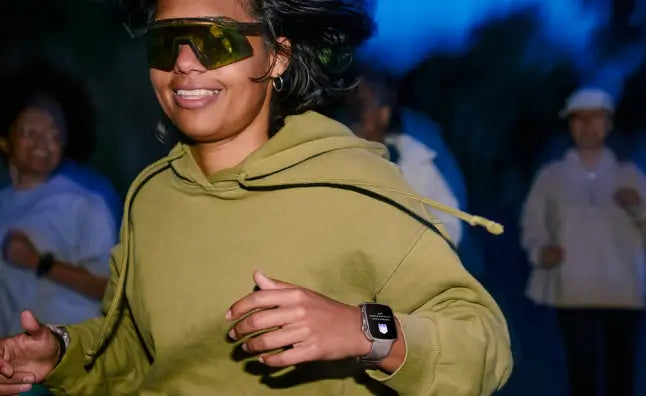Activity Tracking: What Your Watch Is Really Measuring

Your fitness tracker buzzes. "You've reached your activity goal!" But… what exactly did you achieve? And what does "activity" mean?
When we talk about "activity" on a smartwatch or fitness tracker, we're really talking about a mix of different data points. It usually includes things like steps, calories burned, distance moved, and time spent being physically active. Some watches go further—tracking movement intensity, standing time, or even time spent in specific heart rate zones.
Basically, your watch is trying to sum up how much you've moved and how hard your body's been working. But every brand defines this a little differently. That's why two people with different trackers can do the same workout and get totally different stats.
In this post, we'll break down the most common activity metrics—what they mean, how they're measured, why they matter, and how you can use that data to support your fitness goals—without getting lost in the numbers.
Steps Tracking: Not Just a Pedometer
Before we dive into more advanced metrics, let's start with the most common one: steps. Almost every fitness tracker or smartwatch counts steps, and for good reason. It's a simple, easy-to-understand way to gauge how active you've been throughout the day.
How Trackers Count Your Steps
Step tracking may sound simple, but how does it actually work? Your watch doesn't see your feet. Instead, it uses built-in motion sensors, like accelerometers, to detect steady, repeated movements—like the rhythm of walking or running. When your arm swings in a certain way, your watch counts it as a step.
What Affects Step Count Accuracy
Step counts are not always perfect. Wrist position, walking style, and even which arm you wear your watch on can make a difference. For example, if you're pushing a stroller or keeping your hands in your pockets, your watch might miss some steps. On the other hand, you might get extra steps from waving your arms, typing, clapping, or cooking.
That's why some trackers are more accurate than others. Most brands adjust their step-counting algorithms over time to reduce errors. Runmefit watches, for example, use smart motion detection that looks at your pace and movement pattern. This helps cut down on false steps and makes your count more accurate—whether you're walking outside or pacing indoors.
The key is not to stress about small differences. As long as you're moving more overall, your step count is doing its job. Steps are a helpful starting point for tracking your daily activity.
Calories Tracking: A Useful Trends
Next up is calories—another familiar number. it's one of the most popular numbers on any fitness tracker. But it's also one of the most misunderstood. Let's clear up how your watch calculates it and what you can actually do with that info.
How Your Watch Calculates Calories
First, a quick note: "kcal" is just another way of saying "calorie" when it comes to fitness tracking. Your watch doesn't know exactly how many calories you burn. What your watch is really doing is estimating how much energy your body used while you moved around.
To make this estimate, your watch combines a few things: your age, weight, height, gender, heart rate, and movement data. Some trackers even consider the type of exercise you're doing.
Even high-end trackers rely on algorithms and averages. That's why Runmefit recommends setting up your profile with accurate info. The more accurate your profile info is, the better your calorie estimates will be.
Why Track Calories
Even though calorie estimates aren't 100% accurate, they can still help you spot trends and patterns: Are you moving more today than yesterday? Are your workouts getting longer or more intense? It's not about precision—it's about awareness.
Runmefit watches, for example, show total calories include everything your body burns throughout the day. This can be a great motivator. You can see how your efforts add up without getting stuck on the exact numbers.
You should use calorie tracking to notice trends, stay motivated, and build good habits. It's a tool to help you move in the right direction—not a number to stress over.
Distance Tracking: GPS or No GPS?
Distance tracking is especially useful for outdoor activities. If you've ever gone for a run or a long walk, you've probably glanced at your watch to see how far you went. But how does your tracker actually know the distance?
It depends on the model. Some fitness trackers use GPS (Global Positioning System), while others rely on step estimation to guess how far you've traveled.
Here's the difference:
- With GPS: Your watch connects to satellites to pinpoint your location. It then calculates the distance you've covered based on your route. This is the most accurate option—especially for runners, cyclists, and hikers.
- Without GPS: The tracker estimates distance based on your step count and stride length. It's a simpler method and works well for general use, but it's less precise. For example, walking uphill or changing pace a lot can throw off the estimate.
Do You Need GPS or Not?
So, do you need GPS? Not everyone does. If you're walking to stay active or hitting step goals, a GPS-free model is often enough. But if you care about running pace, exact distance, or outdoor routes, GPS is worth having.
The trade-offs? GPS watches usually cost more and use more battery. But some, like certain Runmefit models, offer connected GPS. That means your watch uses your phone's GPS when nearby—so you get accuracy without the bulk or battery drain of a built-in system.
In short: If you're a runner, cyclist, or serious hiker, GPS is worth it. For everyday walkers or those mainly focused on step goals, step-based distance tracking works just fine.
Other Activity Metrics
Step counts and calorie burns aren't the whole story. Most fitness watches track a few other metrics to give a fuller picture of how active you really are throughout the day. But here's where things start to differ—every brand has its own way of doing this.
Let's look at a few examples:
- Apple Watch tracks three main activity rings: Move (calories burned), Exercise (minutes of elevated heart rate), and Stand (hours you've stood up and moved at least a bit). It encourages small bursts of movement throughout the day—not just long workouts.
- Fitbit uses Active Zone Minutes, which count time spent in higher heart rate zones. This focuses more on workout intensity rather than just duration.
- Garmin features Intensity Minutes, similar to Fitbit, helping you gauge how much moderate to vigorous activity you've done in a week.
- Runmefit combines step tracking, calorie burn, distance, standing times, and intensity minutes into a well-rounded daily movement goal. It's a great setup if you're looking for an all-day motivator without too many numbers to juggle.
Each brand focuses on different things, which is why numbers vary from watch to watch. Some push you to move every hour. Others reward high-intensity exercise. What matters most is finding a system that motivates you.
These extra metrics are especially helpful if you're not doing structured workouts but still want to stay active—like standing more at work, walking the dog, or taking the stairs. They encourage short, frequent movement breaks—not just gym time. Even small efforts can add up.
Recommended Fitness Trackers
With so many fitness watches out there, how do you pick the right one? It really depends on what you want to track—and how much you want to spend.
If you're just getting started and want something simple, affordable, and reliable, Runmefit watches are a solid choice. They cover all the basics like steps, distance, and calories, plus they're easy to use and don't overwhelm you with data. Perfect for everyday movement and casual fitness goals.
If you're just getting started and want something simple, affordable, and reliable, Runmefit WATCH 4 will be a solid choice. They cover all the basics like steps, distance, and calories. They're also easy to use and don't overwhelm you with data. Perfect for everyday movement and casual fitness goals.
Runmefit now includes a Medals system, which adds a fun twist. It's great for people who enjoy daily goals and motivation through badges and challenges. And if you want more from your device, Runmefit can still be your favorite pick—it supports everything from fitness tracking to notifications.
When choosing, ask yourself:
Do I need GPS?
Will I wear it all day or just during workouts?
Do I care more about simplicity or advanced data?
Also think about comfort, battery life, screen size, and ease of use. You don't need the fanciest option. Once you know your needs, it's easier to find a fitness watch that fits your lifestyle—and keeps you moving.
Final Thoughts
At the end of the day, your fitness tracker is a tool—not a scoreboard. It's there to help you notice patterns, stay motivated, and build healthy habits over time. The numbers don't have to be perfect to be useful.
Don't stress if your step count is off by a few hundred or if your calorie burn seems lower than expected. What matters is that you're moving, staying consistent, and using the data to make small, positive changes.
So whether you're walking more, running farther, or just standing up a little more often, your watch is right there with you—cheering you on, one step at a time.
Recent News

Activity Tracking: What Your Watch Is Really Measuring

How to Find Your Ideal Heart Rate Zone & Train Better with a Runmefit Smartwatch

